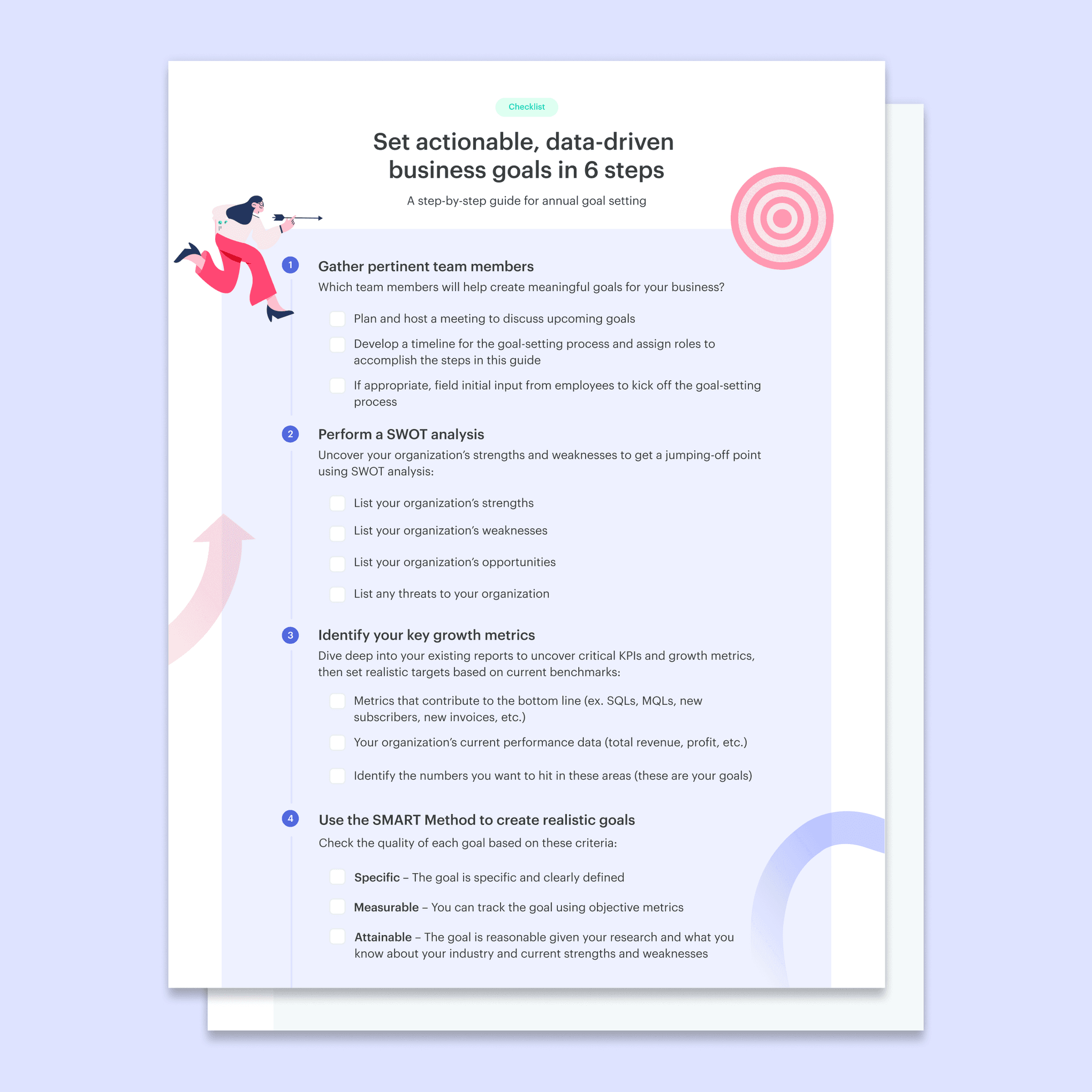Katrina Oko-Odoi
Sr. Content Marketing Manager
Goals are pretty dang important for organizations — because they help employees know what they’re collectively aiming to achieve. Without goals, it’s like playing soccer with no nets. You can run as fast as possible, but if you don’t have anywhere to kick the ball, you’re putting out a lot of energy without any way to measure your success.
Setting goals is extremely helpful to identify meaningful strategies for growth and help your team organize and prioritize their efforts to stay on track with those strategies. Goals make it easier for teams to collaborate and ensure everyone is on the same page — plus they help boost efficiency and show you just how successful your efforts were and whether anything needs to be tweaked for next time.
Becoming effective at this process comes down to setting goals that are actionable. It doesn’t help to set vague goals like “increase profit” or “get better results”; instead, think of goal setting as a means to increasing profit and getting better results. Effective business goals are clear, purposeful and achievable.
We’ve broken down the steps for how to set goals for business in 2023 and beyond.
How to set business goals in 6 steps
Follow these six steps for a straightforward path towards clear business goals.
1. Pull in the entire team
Setting business goals should be a collaborative process across all teams and departments. Each department can have its own goals, but every group should also lend some input to the company’s overarching goals.
Goal setting is an excellent way to align sales and marketing and make sure all areas of the business are on the same page from the jump. You might hold a series of goal-setting workshops for different teams, or send out an internal employee survey to help you gauge the biggest priorities. Whatever you do, find a way to make everyone feel like they have an avenue for giving their input.
2. Perform a SWOT analysis
SWOT is short for: “strengths, weaknesses, opportunities and threats.” A SWOT analysis is a way to identify your company’s current strengths and weaknesses in a more objective manner. Performing a SWOT analysis can help leaders understand where your company is thriving, uncover areas that need improvement and opportunities to improve, and provide a great jumping-off point for your business goals.
The more data you can bring in to inform your analysis, the better — from web analytics to CRM data, sales metrics and more.
3. Identify your key growth metrics
To set meaningful and actionable goals, start by identifying your key growth metrics and primary drivers. Perhaps your growth is tied to certain sales KPIs, or maybe you’re focused on specific revenue targets. Either way, it’s essential to identify the activities that most contribute to growth in your organization. Your business goals will likely revolve around the numbers you need to hit to see improvement in those areas.
For example, if you’re a SaaS company, your growth driver might be the number of subscriptions you have on your platform, or the total monthly recurring revenue (MRR) of those subscriptions. Say you currently have around 50 new sign-ups each week. Calculate an approximate MRR for those sign-ups. You might make your growth goal to gain 60 new sign-ups per week for the new year, and translate that into a target total MRR that you’ll aim to hit.
It all comes down to finding your “north star” metric that is the greatest contributor to your organization’s growth and the other metrics and activities that help improve it. Focus your goal on improving that metric (or those metrics) in a measurable way.
4. Use the SMART method and best practices to create realistic goals
Once you’ve identified your growth metric and have some tangible number goals, consider using the SMART method to determine the quality of your goal:
- Specific – The goal is specific and clearly defined
- Measurable – You can track the goal using objective metrics
- Attainable – The goal is reasonable given your research and what you know about your industry and current strengths and weaknesses
- Realistic – You have all the resources you need to actually reach your goal
- Timely – You have a timeline, and it is possible to reach the goal within that timeline
Use the SMART method to stress test and adjust each goal to make sure that it’s a good fit for your organization. Also double-check that they align with established business goal-setting best practices by considering the following:
- Your goal is ambitious enough to drive the desired growth (based on current metrics)
- It aligns with your company’s vision and mission statements
- It takes into account external factors like economic, social, legal, environmental, political, seasonal and technological issues
- The goal will not have a negative impact on your customers and investors — or, the impact will be very minor
- Your whole team is on board
Using the SMART method will help you set reasonable yet challenging goals for your organization.
Get the latest from our blog every month
5. Develop a plan for making your goals happen
Once you know your business goals, drill down into how you’ll achieve them. This involves determining how to execute on each goal inside your existing business practices — or developing new processes to make them attainable. Take time to create or modify sales and marketing plans that align with each goal.
You’ll likely have short- and long-term goals that involve multiple teams and people. Take time to work across teams to craft an overarching plan for achieving your goals, and then require each individual team to develop their own more task-oriented plan and timeline for making progress towards their corresponding goals each quarter. (For more on how to write a sales business plan, click here).
6. Communicate the goals to the entire organization
Once you’ve finalized your goals, the final step is sharing them with the entire organization. Even if individual teams and employees contributed in the early goal brainstorming process, chances are the leadership team finished crafting them and fine-tuned the targets, possibly with input from other stakeholders. This is your chance to communicate the final goals to every employee so everyone is included and has a big-picture understanding of what you’ll be working towards together.
Many organizations have all-hands meetings or quarterly business reviews where they discuss progress made and goals for the upcoming quarter. Depending on established practices at your company, an email or a team meeting could also suffice.
Straightforward communication about goals from the beginning helps get everyone on the same page. It’s also important to communicate the goals in a way that gains employees’ buy-in and demonstrates why they should care about working toward those goals. After you’ve introduced the business goals, everyone should have a clear idea of:
- The goal(s)
- How the business processes will be altered to achieve these goals
- Their role in the plan
- How frequently the goals will be measured
Once everyone is clear on what they’re working towards, you can all put your heads together as a team to make it happen.
Bring your business goals to life
Setting business goals comes down to getting a clear idea of where you are now and where you want to be — and then creating targets and a game plan for how to get there. By following these six steps, you’ll be on your way to creating and achieving greater heights in your business.
Now that you know how to set business goals, it’s your turn to do it. Download our free business goal-setting worksheet to help guide your process:

Your worksheet
A step-by-step guide for annual goal setting
Set realistic and achievable business goals and get your team excited about them.






